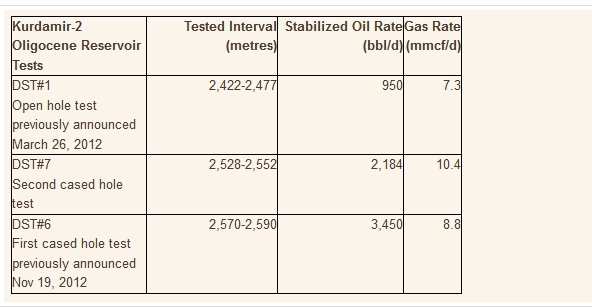
WesternZagros Resources has announced that it and the operator, Talisman, are preparing to complete the Kurdamir-2 well after successfully finishing an additional cased-hole test in the Oligocene Formation (DST#7).
The test was conducted over a 24 metres thick interval between depths of 2,528 metres and 2,552 metres. It achieved a stabilized flow rate of 2,184 barrels per day (“bbl/d”) of light, 42 degree API oil, together with 10.4 million cubic feet per day (“mmcf/d”) of natural gas.
The gas to oil ratio likely indicates a partial contribution from the gas cap due to free gas drawdown through natural fractures in the reservoir. The 3.5 inch tubing size used to conduct this test, together with the unanticipated gas contribution from the gas cap, restricted the oil flow from the reservoir.
As a result, the Operator and WesternZagros have agreed that further tests of shallower zones in the Oligocene reservoir are unnecessary and are now working together on plans to realize the maximum oil production potential from the Oligocene reservoir in Kurdamir-2, potentially through an extended well test subject to the approval of the Kurdistan Regional Government.
Simon Hatfield (pictured), WesternZagros’s Chief Executive Officer commented:
“This second cased hole test in the Oligocene further reinforces our view that Kurdamir is a giant discovery. The results of the entire Oligocene testing program have exceeded our expectations for both thickness of oil column and reservoir quality.
“It is apparent that the intervals tested have excellent permeability and, with optimally designed well completions to isolate the gas cap, are expected to yield oil production rates far in excess of the currently constrained rates.
“The results continue to support our belief that the Oligocene has the potential to hold over a billion barrels of recoverable oil. We are excited about our next appraisal well in the Kurdamir structure at Kurdamir-3. Kurdamir-3 will spud as soon as possible in the new year.“
This most recent cased-hole test was conducted over a perforated interval of 24 metres thick in fractured carbonates in the main porous zone of the Oligocene reservoir. The flow rates of 2,184 bbl/d of light oil and 10.4 mmcf/d of natural gas were recorded after flowing and stabilizing the well for three days at progressively larger choke sizes.
The stabilized rate was achieved on a 44/64″ choke with a wellhead flowing pressure of 1,705 psi. The oil was high-quality 42 degree API and no formation water was detected. The oil rate was restricted due to gas choking within the 3.5 inch completion tubing. The gas to oil ratio is indicative of gas being drawn down from the gas-oil contact, which is 83 metres above the test interval. Larger diameter tubing would allow higher oil test rates.
For example, the Company expects that the interval previously tested in DST#6 could flow oil at rates up to 7,000 bbl/d if larger tubing is used. The Company is in the process of completing a similar analysis for DST#7 and to determine the optimum tubing size for the completion.
The table below summarizes the flow rates from all three intervals tested within the 168 metres gross hydrocarbon column (22 metres of gas and 146 metres of oil) encountered in the Oligocene reservoir in the Kurdamir-2 well. The three intervals are composed of the two recent cased hole tests (DST#6 and DST#7) and the first open hole test conducted in March 2012 (DST#1) which was conducted across the gas-oil contact.

The Kurdamir-2 test and wireline log data have been analyzed in order to update contingent and prospective resource estimates for the Oligocene reservoir. The Company expects that the contingent resource estimates will materially increase. Updated resource estimates will be publicly released once confirmed by the Company’s independent auditors.
The current independently audited unrisked mean estimates for the contingent resources in the Oligocene reservoir of the Kurdamir structure are 990 billion cubic feet of gas, 39 million barrels (“MMbbl”) of condensate and 147 MMbbl oil as of April 20, 2012. The current independently audited unrisked mean estimate for the prospective resources in the Oligocene reservoir is 1,150 MMbbl prospective oil resources as of May 31, 2012.
Following the completion of Kurdamir-2, the Operator will move the rig to the Kurdamir-3 well location for an anticipated spud date in February 2013.
WesternZagros and Talisman each have a 40 percent working interest in the Kurdamir Block with the Kurdistan Regional Government (“KRG”) holding the remaining 20 percent.





